Catholic Total Abstinence Union Fountain
The Catholic Total Abstinence Union Fountain (1874–77) – also known as The Catholic Total Abstinence Centennial Fountain or The Centennial Fountain – is a now defunct ornamental fountain and drinking fountain located in West Fairmount Park, Philadelphia, Pennsylvania. Created as an attraction for the 1876 Centennial Exposition, it was commissioned by the Catholic Total Abstinence Union of America, a religious organization that advocated for total abstinence from alcohol.
| Catholic Total Abstinence Union Fountain | |
|---|---|
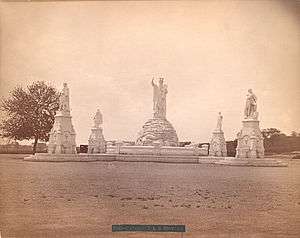 | |
| Artist | Herman Kirn, designer & sculptor Thomas McElwee, portrait medallions[1] Isaac H. Hobbs & Son, architects |
| Year | 1874-77 |
| Type | Fountain and water fountain |
| Location | Avenue of the Republic & States Street, West Fairmount Park, Philadelphia, Pennsylvania |
Creation
The fountain was intended to symbolize "the power of religion, the virtues of temperance, and the Irish Catholic love of patriotism and liberty."[2] It was designed by German-born-and-trained sculptor Herman Kirn, who was living in Philadelphia.[3] In February 1874, he exhibited a 12-foot diameter plaster of Paris model at the city's Academy of Music.[4] Fund-raising for the project was slow, and it wasn't until the following autumn that Kirn formally received the commission.[5] Tyrolean marble was chosen for the statues, and Kirn moved to southern Austria to carve them at a quarry in Laas.[6]
Description
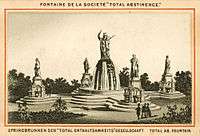
The fountain's 100-foot-wide stepped base is of granite, and in the shape of a Maltese cross. At center is a 40-foot diameter basin featuring a 15-foot statue of Moses, who clutches the Ten Commandments with his left arm, holds his staff (now missing) in his left hand, and points skyward with his shofar or horn (now missing) in his right hand. He stands upon a beehive-shaped mound of marble that signifies the Rock of Horeb, which God instructed Moses to strike with his staff to provide water for the Israelites.[7] The fountain was fed by a reservoir atop nearby George's Hill, and small waterfalls flowed from the rock mound.[8] The basin's marble outer wall features six portrait medallions of prominent Roman Catholics who fought in the Revolutionary War – including George Meade,[9] Count Casimir Pulaski and the Marquis de Lafayette – and the seal of the Total Abstinence Union. Outside the basin, on the arms of the cross, are four larger-than-life subsidiary statues of prominent American Roman Catholics – Archbishop John Carroll, Charles Carroll of Carrollton, Father Theobald Mathew, and Commodore John Barry. Each statue's granite pedestal featured four lion-head spouts from which water flowed, for a total of sixteen drinking fountains.
Dedication
The fountain was dedicated on July 4, 1876; following a mass at the Cathedral of Saints Peter and Paul; and a parade of more than 5,000 north on Broad Street, west on Girard Avenue, and over the Girard Avenue Bridge to the Centennial fairgrounds.[10] Composer Edward Mack wrote the "Centennial Fountain Grand March" for the occasion.[11] Speeches were made by prominent Catholic clergy and individuals, culminating in a final blessing by Father James O'Reilly:
Oh God, by whose word all things are made holy, give Thy blessing to this Fountain, and grant that whosoever will make use with thanksgiving, according to Thy will and Thy law, may, through the invocation of Thy most holy name, receive from Thee health of body and spiritual protection, through Christ our Lord, Amen.[12]
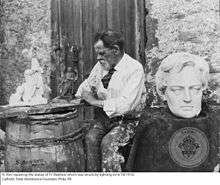
The fountain itself was operational for the dedication, including the sixteen pedestal drinking fountains, but only the statue of Commodore Barry was in place. The other four were still in Austria, and in various states of completion. It remained in this condition through the November 1876 closing of the exposition, and beyond. The Father Matthew, Archbishop Carroll, and Charles Carroll of Carrollton statues were dedicated on March 17, 1877 (Saint Patrick's Day); and the central Moses Striking the Rock of Horeb statue was dedicated on July 4, 1877.[13]
Later history
The statue of Father Matthew was damaged by lightning on June 18, 1910.[14] Sculptor Kirn, who had modeled it 35 years earlier, repaired it.[15]
Gallery
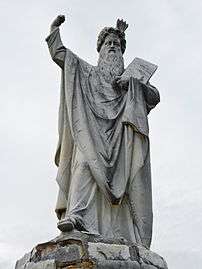 Moses Striking the Rock of Horeb.
Moses Striking the Rock of Horeb.- Archbishop Carroll.
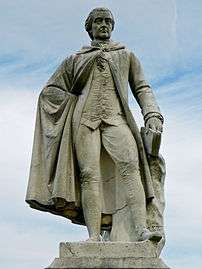 Charles Carroll of Carrollton.
Charles Carroll of Carrollton.- Father Matthew
- Commodore Barry.
 Herman Kirn w. J. Carroll ca. 1875
Herman Kirn w. J. Carroll ca. 1875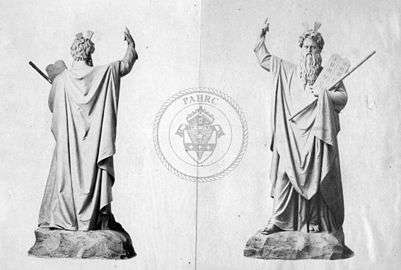 Herman Kirn clay model for Moses, Catholic Total Abstinence Union Fountain.
Herman Kirn clay model for Moses, Catholic Total Abstinence Union Fountain.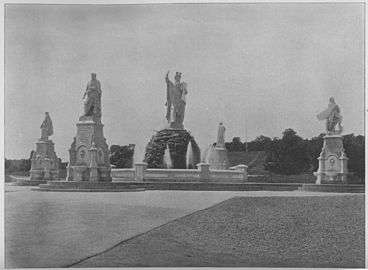 Photo of Fountain w. water running.
Photo of Fountain w. water running.
See also
References
| Wikimedia Commons has media related to Catholic Total Abstinence Union Fountain. |
- Gallagher, p. 4.
- "The Centennial Fountain," Potter's American Monthly Magazine, vol. 6, no. 49 (January 1876), p. 70.
- Little is known about Herman Kirn. He had been a student of sculptor Carl Johann Steinhauser of Karlruhe, Germany, who provided letters of recommendation, (Gasparini, p. 26). Kirn's only other major work is an 1883 statue of William Penn, titled Toleration, also in Fairmount Park. In later years, Kirn worked as caretaker for the sculpture collection in Fairmount Park, (Gasparini p. 55). He may have been the Herman F. Kirn, Sr. who died in Reading, Pennsylvania in 1929.
- Gasparini, pp. 23-24.
- Gasparini, p. 27.
- Gasparini, p. 40. Note: Following World War I, the Austrian region of South Tyrol became part of Italy.
- Exodus 17:6 – "Behold, I will stand before thee there on the rock of Horeb; and thou shalt smite the rock, and there shall come water out of it, that the people may drink."
- Gasparini, pp. 16-17. George's Hill overlooks the fountain, and is the site of the Mann Center for the Performing Arts.
- Atzbach, Nicole (2016). Portraits in Conversation: Francisco de Goya and Vicente López y Portaña (lecture). Meadows Museum. Event occurs at 41m45s. Retrieved September 17, 2018.
- Gasparini, p. 42.
- Centennial Fountain Grand March from Library Company of Philadelphia.
- Joseph Skelton Longshore & Benjamin Knowles, "The Total Abstinence Benevolent Union Demonstration," The Centennial Liberty Bell, (Philadelphia: Claxton, Remsen & Haffelfinger, 1876), pp. 176-82.
- Gasparini, p. 45.
- The Monumental News, August 1910, p. 573.
- "H. Kirn repairing the statue of Fr. Matthew," from Philadelphia Archdiocese Historical Research Center.
Sources
- Daniel J. Gallagher, The Catholic Centennial Fountain Illustrated: A Tribute of the Catholics of America to the Centennial of the Nation's Birth (Philadelphia: Daniel J. Gallagher, 1877).
- Daria A. Gasparini, A Celebration of Moral Force: The Catholic Total Abstinence Union of America Centennial Fountain, masters thesis, University of Pennsylvania, 2002.
External links
- Aerial Video by Serge Maslennikov from YouTube.
- Catholic Total Abstinence Union Fountain from SIRIS.
- Catholic Total Abstinence Union Fountain from Philadelphia Archdiocese Historical Research Center.
- Catholic Total Abstinence Fountain from Getty Images.